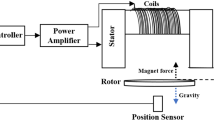Abstract
This paper discusses a closed-loop centralized control for a multi-input multi-output active magnetic bearing system. A genetic algorithm for design and a credible comparison of different controller structures are proposed. The evaluation of the design trade-offs of linear-quadratic and loop transfer recovery controllers are studied. The model-based controllers are compared with the classical PID controller and the cascaded PI/PD controller. The properties of the tested control configurations are examined using maximum singular values of the output sensitivity function of the closed-loop system and the tolerated disturbance at the input of the plant. Furthermore, indices such as measured peak output sensitivity, singular values of the uncertain control system, responses to the step reference position, step disturbance, and impulse force disturbance are examined. A good agreement between the simulation and the experimental results from the test-rig is shown.
Similar content being viewed by others
References
Polajzer B, Ritonja J, Stumberger G, Dolinar D, Lecointe J-P (2006) Decentralized PI/PD position control for active magnetic bearings. Electr Eng 89(1): 53–59
Schroder P, Chipperfield AJ, Fleming PJ, Grum N (1997) Multi-objective optimisation of distributed active magnetic bearing controllers. In: IEE Proceedings of the 2nd International Conference on Genetic Algorithms in Engineering Systems: Innovations and Applications, pp 13–18
Schroder P, Green B, Grum N, Fleming PJ (1998) On-line genetic auto-tuning of mixed H2/H∞ optimal magnetic bearing controllers. In: IEE Proceedings of the International Conference on Control, pp 1123–1128
Chang H, Chung SC (2000) Integrated design of radial active magnetic bearing systems using genetic algorithms. Mechatronics 12: 19–36
Chen HC, Chang SH (2006) Genetic algorithms based optimization design of a PID controller for an active magnetic bearing. Int J Comput Sci Netw Sec 6(12): 95–99
Zhuravlyov YN (2000) On LQ-control of magnetic bearing. IEEE Trans Control Syst Technol 8(2): 344–350
Jastrzębski RP (2007) Design and implementation of FPGA-based LQ control of active magnetic bearings. Dissertation, Lappeenranta University of Technology, Finland. http://urn.fi/URN:ISBN:978-952-214-509-3
Lösch F (2002) Identification and automated control design for active magnetic bearing systems. Dissertation, Swiss Federal Institute of Technology, Zurich, Switzerland
Grega W, Piłat A (2005) Comparison of linear control methods for an AMB system. Int J Appl Math Comput Sci 15(2): 245–255
Grochmal TR, Lynch AF (2007) Experimental comparison of nonlinear tracking controllers for active magnetic bearings. Control Eng Pract 15: 95–107
Lantto E (1999) Robust control of magnetic bearings in subcritical machines. Dissertation, Helsinki University of Technology, Finland
Tsiotras P, Wilson BC (2003) Zero- and low-bias control designs for active magnetic bearings. IEEE Trans Control Syst Technol 11(6): 889–904
Nerg J, Pöllänen R, Pyrhönen J (2005) Modeling the force versus current characteristics, linearized parameters and dynamic inductance of radial active magnetic bearings using different numerical calculation methods. WSEAS Trans Circuits Syst 4(6): 551–559
Franklin GF, Powell JD, Workman M (1998) Digital control of dynamic systems, 3rd edn. Addison-Wesley, Reading
Skogestad S, Postlethwaite I (2007) Multivariable feedback control, 2nd edn. Wiley, England
Kwakernaak H (1969) Optimal low-sensitivity linear feedback systems. Automatica 5(3): 279–285
Meng X, Song B (2007) Fast genetic algorithms used for PID parameter. In: IEEE Proceedings of the International Conference on Automation and Logistics, pp 2144–2148
Takahashi N, Fujiwara H, Matsushita O, Ito M, Fukushima Y (2007) An evaluation of stability indices using sensitivity functions for active magnetic bearing supported high-speed rotor. Trans ASME J Vib Acoust 129: 230–238
Author information
Authors and Affiliations
Corresponding author
Rights and permissions
About this article
Cite this article
Jastrzębski, R.P., Pöllänen, R. Centralized optimal position control for active magnetic bearings: comparison with decentralized control. Electr Eng 91, 101–114 (2009). https://doi.org/10.1007/s00202-009-0121-2
Received:
Accepted:
Published:
Issue Date:
DOI: https://doi.org/10.1007/s00202-009-0121-2




